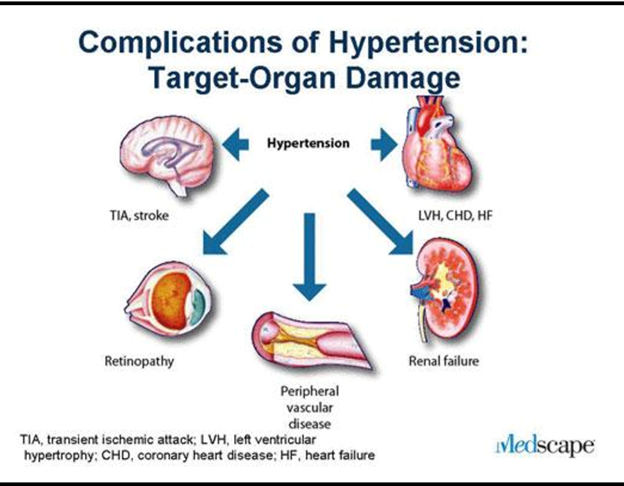Complications and Target Organ Damage
- Hypertension can lead to serious complications and target organ damage if left untreated or poorly controlled. Target organs are those that are most affected by high blood pressure and include the heart, brain, kidneys, eyes, and arteries. Some of the common complications and target organ damage caused by hypertension are:
- Stroke: Hypertension is a major risk factor for stroke, which occurs when there is reduced blood flow or bleeding in the brain. Stroke can cause permanent disability or death depending on the location and extent of brain damage. Symptoms of stroke include sudden weakness or numbness on one side of the body, face drooping, slurred speech, confusion, difficulty seeing, severe headache, dizziness, loss of balance, or loss of consciousness.
- Heart attack: Hypertension can increase the risk of heart attack by causing coronary artery disease (CAD), which is a condition in which plaque builds up in the arteries that supply blood to the heart muscle. Plaque can narrow or block the arteries and reduce blood flow to the heart. If a plaque ruptures and forms a clot, it can completely block an artery and cause a heart attack
- Management and Treatment Options
- Pharmacologic therapy: antihypertensive drugs such as diuretics, beta-blockers, calcium channel blockers, angiotensin-converting enzyme inhibitors, angiotensin II receptor blockers, etc.
- Lifestyle modifications: weight reduction, dietary sodium restriction, regular physical activity, moderation of alcohol intake, smoking cessation, stress management, etc.
- Patient education: the importance of adherence to medication regimen, self-monitoring of blood pressure, recognition of signs and symptoms of complications, follow-up care, etc.

Nursing Test Bank
Naxlex Comprehensive Predictor Exams
Questions on Complications and Target Organ Damage
Correct Answer is C
Explanation
Correct Answer is C
Explanation
Correct Answer is B
Explanation
Correct Answer is D
Explanation
Correct Answer is C
Explanation
Correct Answer is D
Explanation
Correct Answer is D
Explanation
Correct Answer is A
Explanation
Correct Answer is C
Explanation
Correct Answer is B
Explanation
Correct Answer is B
Explanation
Correct Answer is C
Explanation
Correct Answer is C
Explanation
Correct Answer is C
Explanation
Correct Answer is B
Explanation
Correct Answer is A
Explanation
Correct Answer is D
Explanation
Correct Answer is B
Explanation
Correct Answer is A
Explanation
Correct Answer is B
Explanation
Correct Answer is D
Explanation
Search Here
Related Topics
- Enteral nutrition (EN) - Blood and Cardiovascular Disorders
- Mobility devices: crutches, canes, continuous passive ROM machine. - Blood and Cardiovascular Disorders
- Bandaging - Blood and Cardiovascular Disorders
- IV insertion - Blood and Cardiovascular Disorders
- Immunodefeciency disorders - Blood and Cardiovascular Disorders
More on Nursing
Free Nursing Study Materials
Access to all study guides and practice questions for nursing for free.
- Free Nursing Study Trials
- Free Nursing Video tutorials
- Free Nursing Practice Tests
- Free Exam and Study Modes
- Free Nursing Revision Quizlets
